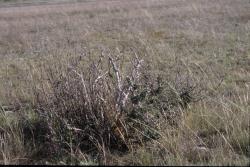- Taxon
- Gallery
Shrub to 1.2(–1.5) m tall and 1.5 m wide, up to 18 main branches, with an open habit, deciduous or semi-deciduous; tap root up to 25 mm diam. near crown. Branches originating at and below ground level or sometimes rhizomatous, slender, usually spreading to decumbent, sometimes upright, stiff but flexible at the base, up to 40 mm diam. and 1.5 m long; new branches upright and sometimes epicormic, up to 40 cm high. Outer bark light grey to light grey-brown and smooth on young branches, becoming light brown, rough, and longitudinally furrowed on old branches. Branchlets light grey to dark brown, slender, terete, glabrous to sparsely hairy, diverging between 40° and 70°, terminal branchlets of main shoots often more acute (20° to 40°), internodes 10–40 mm apart, with brachyblasts; 2-ridged, the raised ridges usually light brown. Brachyblasts opposite, decussate, rough with closely packed petiole bases, up to 5 mm long and 2 mm wide, each with 1–7 leaves. Seedling with a prominent taproot, main stem initially upright and then decumbent, decumbent shoots arising from lowest 1–4 leaf axils, stems 2-ridged, green and flushed red, with sessile glandular and dolabriform hairs, some simple eglandular hairs with a distinct red stalk; leaves alternate or in opposite pairs, if alternate becoming opposite at nodes 4–6, up to 23 × 6 mm, obovate to elliptic, green, spreading, apex subacute to obtuse with a small red apiculus, base attenuate to cuneate, petiole 8–10 mm long, hairs sparse glandular and dolabriform. Adult leaves opposite or in fascicles on brachyblasts, 3.4–13.8 × 2.2– 4.1 mm, narrowly obovate to broadly obovate, occ. oval, sometimes slightly falcate, midrib slightly raised, main veins obscure; adaxial surface light green, grey-green to brown-green, with a silvery sheen, yellow-green when old, sparsely to moderately hairy; abaxial surface clad in dense silvery white appressed tomentum; hairs dolabriform, base short; petiole 1.0–1.3 mm long, red to red-brown, proximal part black to black-brown, abaxial surface moderately to densely hairy, adaxial surface sparsely to moderately hairy; base attenuate to cuneate; margin red or red-brown, occ. revolute, sparsely hairy to glabrate; apex obtuse with a small red to redbrown apiculus. Capitula 1–6 per brachyblast. Pedicels 1.2–4.0 mm long, densely covered with appressed dolabriform hairs. Bracteoles 2(–4), 0.5– 0.7 × 0.4–0.5 mm, narrowly triangular, abaxial surface densely hairy, adaxial surface glabrous. Involucre conical in bud, cylindric at maturity; involucral bracts 18–22, 4–5-seriate, green, flushed red, patent to recurved at maturity, apices acute, slightly keeled in proximal half, abaxial surface and margin sparsely to moderately covered in glandular and appressed simple eglandular hairs, adaxial surface glabrous; outer bracts 0.7–2.0 × 0.4–0.5 mm, ovate, short lanceolate to narrowly triangular; inner bracts 3.0–4.0 × 0.7–0.8 mm, lanceolate. Florets 8– 12 per capitulum. Female florets 0–3, limb white, 2.8–3.8 × 1.1–1.4 mm, glabrous. Hermaphrodite florets actinomorphic; corolla usually with glandular hairs near apex, occasionally with simple eglandular hairs or glabrous; lobes 5, 1.4–2.4 × 0.4–0.6 mm, deflexed at maturity, white; tube 2.2–2.6 mm long, green. Style of female and hermaphrodite florets 4.2–4.5 mm long; style arms 1.2–2.0 mm long, 0.20–0.25 mm wide, purple; ovary 1.6–2.0 × 0.5– 0.6 mm, sparsely to moderately covered with glandular hairs, occasionally with a few simple eglandular hairs; pappus bristles scabrid, 2.9– 4.2 mm long, greyish white. Anthers 1.5–1.8 mm long; apex apiculate, 0.2–0.3 mm long; tails < 0.1 mm long. Filaments 1.1–1.2 mm long, glabrous.
[Reproduced from Heenan & Molloy (2004, New Zealand J. Bot. 42: 21–36) with permission from The Royal Society of New Zealand.]




